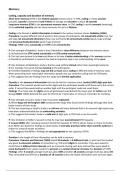Class notes
A level psychology memory revision/lesson notes
- Course
- Institution
Hello - I hope these notes find you well. These notes are for everything you need to know in memory psychology! They cover all lessons and the format to these notes are very easy to use. They contain notes written in a 16 marker structure with an extensive amount of AO1 first for you to choose from...
[Show more]



